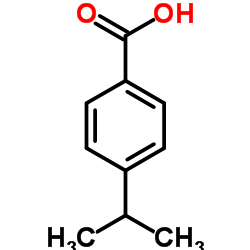4-异丙基苯甲酸

4-异丙基苯甲酸结构式

|
常用名 | 4-异丙基苯甲酸 | 英文名 | 4-Isopropylbenzoic acid |
|---|---|---|---|---|
| CAS号 | 536-66-3 | 分子量 | 164.201 | |
| 密度 | 1.1±0.1 g/cm3 | 沸点 | 271.8±19.0 °C at 760 mmHg | |
| 分子式 | C10H12O2 | 熔点 | 117-120 °C(lit.) | |
| MSDS | 中文版 美版 | 闪点 | 128.1±16.2 °C | |
| 符号 |

GHS07 |
信号词 | Warning |
|
3D-QSAR and molecular docking studies of benzaldehyde thiosemicarbazone, benzaldehyde, benzoic acid, and their derivatives as phenoloxidase inhibitors.
Bioorg. Med. Chem. 15 , 2006-15, (2007) Phenoloxidase (PO), also known as tyrosinase, is a key enzyme in insect development, responsible for catalyzing the hydroxylation of tyrosine into o-diphenols and the oxidation of o-diphenols into o-quinones. Inhibition of PO may provide a basis for novel env... |
|
|
Anaerobic activation of p-cymene in denitrifying betaproteobacteria: methyl group hydroxylation versus addition to fumarate.
Appl. Environ. Microbiol. 80(24) , 7592-603, (2014) The betaproteobacteria "Aromatoleum aromaticum" pCyN1 and "Thauera" sp. strain pCyN2 anaerobically degrade the plant-derived aromatic hydrocarbon p-cymene (4-isopropyltoluene) under nitrate-reducing conditions. Metabolite analysis of p-cymene-adapted "A. arom... |
|
|
Bacterial metabolism of side chain fluorinated aromatics: cometabolism of 4-trifluoromethyl(TFM)-benzoate by 4-isopropylbenzoate grown Pseudomonas putida JT strains.
Arch. Microbiol. 149(3) , 198-206, (1988) Enzymes of the p-cymene pathway in Pseudomonas putida strains cometabolized the intermediate analogue 4-trifluoromethyl(TFM)benzoate. Three products, 4-TFM-2,3-dihydro-2,3-dihydroxybenzoate, 4-TFM-2,3-dihydroxybenzoate and 2-hydroxy-6-oxo-7,7,7-trifluorohepta... |
|
|
Functional identification of p-cumate operons in the terpene-degrading Rhodococcus sp. strain T104.
FEMS Microbiol. Lett. 266(1) , 54-9, (2007) We identified a p-cumate degrading gene cluster (designated cmt) with a novel organization in our genomic studies of the terpene-degrading Rhodococcus sp. strain T104. The mutant strain SN140, isolated for the inability to grow on p-cumate, accumulates 2,3-di... |
|
|
Identification and expression of the cym, cmt, and tod catabolic genes from Pseudomonas putida KL47: expression of the regulatory todST genes as a factor for catabolic adaptation.
J. Microbiol. 44(2) , 192-9, (2006) Pseudomonas putida KL47 is a natural isolate that assimilates benzene, 1-alkylbenzene (C(1)-C(4)), biphenyl, p-cumate, and p-cymene. The genetic background of strain KL47 underlying the broad range of growth substrates was examined. It was found that the cym ... |
|
|
A study of the toxicity and local anesthetic properties of some derivatives of cumic acid.
J. Am. Pharm. Assoc. Am. Pharm. Assoc. 40(9) , 449-53, (1951)
|
|
|
Synthesis of local anesthetics derived from cumic and 3-nitrocumic acids.
J. Am. Pharm. Assoc. Am. Pharm. Assoc. 39(11) , 644-5, (1950)
|
|
|
Inducible Expression of Agrobacterium Virulence Gene VirE2 for Stringent Regulation of T-DNA Transfer in Plant Transient Expression Systems.
Mol. Plant Microbe Interact. 28 , 1247-55, (2015) Agrotransfection with viral vectors is an effective solution for the transient production of valuable proteins in plants grown in contained facilities. Transfection methods suitable for field applications are desirable for the production of high-volume produc... |
|
|
High-level recombinant protein production in CHO cells using lentiviral vectors and the cumate gene-switch.
Biotechnol. Bioeng. 106(2) , 203-15, (2010) Fast and efficient production of recombinant proteins for structural and functional studies is a crucial issue for research and for industry. To this end, we have developed an efficient system to generate in less than 2 months, starting from the cDNA, pools o... |
|
|
Novel, versatile, and tightly regulated expression system for Escherichia coli strains.
Appl. Environ. Microbiol. 76(15) , 5058-66, (2010) A novel tightly regulated gene expression system was developed for Escherichia coli by applying the regulatory elements of the Pseudomonas putida F1 cym and cmt operons to control target gene expression at the transcriptional level by using p-isopropylbenzoat... |